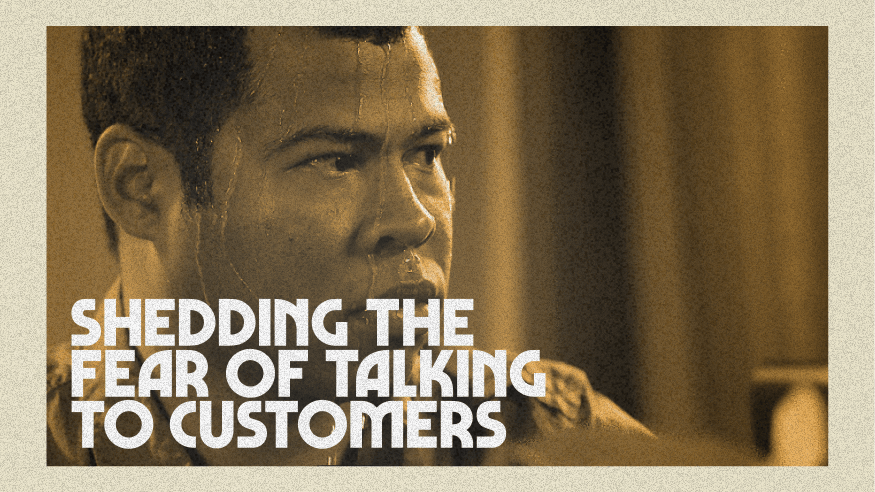How to Use Design to Get Your Ass a Seat at the Table
A step-by-step guide to help transform how your company views design and utilises it for growth instead of decoration

Is there a way to learn how design can drive growth at any company, regardless of its current UX maturity?
It's tempting to think that the only way you can do this is by working for a company that values design.
But guess what?
You don't have to.
With the skills that you already possess, you can demonstrate the value of designing for growth to your leaders and co-workers.
The problem
Companies don't value design in the same way UX mature companies do because their leaders may not have been formally trained to be designers.
So waiting for them to change the status quo isn't going to help your motivation for learning.
For the same reason, leaders don't easily switch to an untested approach because it comes with significant risk and cost to the business if it's not executed properly.
Therefore, going in with your designer guns and demanding a change isn't going to help either.
To transition a business that views design as decoration to one that values it for growth, you need a step-by-step process that helps you make the transition more natural.
This way, your leadership will look back at all the work you've accomplished without even realizing how you got them there.
Sooner or later, you'll be recognised for your effort and you'll earn your ass a seat at the table.
Let's find out how it's done!
Find a pilot project
To get buy-in for a greater design efforts, it's best to start small.
We need to find a low stakes pilot project that will get your momentum going.
You accomplish this by finding an opportunity where you can execute it from start to finish in a lean, rapid way.
There's several methods of finding an opportunity.
The most straightforward approach is to talk to any customer facing team such as support, sales or customer success to find a problem that a significant portion of your user base faces.
When teams describe their own pain or problems, it's usually because they are experiencing a problem that their customers have repeatedly complained about to them.
Be sure to dig into what they say and find patterns.
The key to recognising opportunities that fit our criteria is to look at the problems through three lenses:
1) It has to be desirable for the business to pursue
The most straightforward way to grow a business is to cut costs or increase revenue.
For example, if you find a recurring problem for customers that takes up a hefty amount of time from customer support, can you design something that will significantly decrease the support ticket volume?
Cutting down support volume means that they're spending less time (which means less money) on a low stakes problem and catering to customers with bigger issues and building up customer affinity for the brand.
You'd kill two birds with one stone in this scenario.
2) It shouldn't take months to implement
Working on something for multiple weeks or months is going to sap your motivation to keep working on it.
Something small enough where it doesn't require a lot of resources (or input from a lot of people) and is relatively easy to execute will do just fine.
This could be as simple as adding a piece of copywriting to an existing design that will afford more clarity for the user.
Here's an example of such a problem:
We once had a customer ask us for more complex permission rules. It could easily have taken six weeks to build the change she wanted. Instead of taking the request at face value, we dug deeper. It turned out that someone had archived a file without knowing the file would disappear for everyone else using the system. Instead of creating a rule to prevent some people from archiving, we realized we could put a warning on the archive action itself that explains the impact. That’s a one-day change instead of a six-week project. – Ryan Singer (Author of the Shape Up development methodology)
3) It should be measurable
If there's no way to measure the impact of the design then it's going to be difficult to convince the utility of it to stakeholders and leaders.
To determine if something is measurable, you need to be able to make an apples-to-apples comparison between the current state of the product and how the numbers will change when the new design is implemented.
You can find the baseline metrics by either accessing an analytics tool that your company uses or by talking to someone within the organisation who's responsible for measuring utilisation.
When you're looking at the metrics ask yourself these questions to bolster up your pitch to get buy-in for it:
- How many people are affected by this problem?
- What would happen if we did nothing?
- How much potential revenue is lost due to this problem (if any)?
- What's the upside we can expect if we solve this problem?
Create the pitch
Equipped with an opportunity that's low stakes but high impact, is easy to implement and is measurable... now it's time to build up advocacy to work on it.
But before you do that you need to present evidence to stakeholders to justify investing in it.
A good way to formalise what you've found is to write up a pitch for it.
Here's what you need to include in it:
1) What's the problem you're solving?
Use your findings from the earlier step to create awareness around the problem and motivate leaders and other stakeholders to work on it.
By showing the depth of the problem and incorporating multiple contextual information in the form of a story will lead to a shared understanding of why the status quo doesn't work.
Be sure to include the impact on the business as well to create an internal desire to want to change the status quo.
2) How long are you going to spend working on it?
Given your understanding of the problem, setting the time it'll take to design, build and launch is a constraint that turns stakeholders into a partner in the process.
Anybody can come in and give expensive or complicated solutions. And a better solution is always relative.
Your objective is to keep the timeline tight enough for it to get launched and measured so that you can show results and repeat the process again.
3) What's the solution going to look like?
In order to sell the project, we need to show some visual detail for what the solution could look like.
This doesn't mean that you need to go into a full-blown wireframe or high fidelity design but just enough detail where someone who reads the pitch and looks at the drawings without much context can understand it.
To know if you're doing too much in this step, evaluate if your drawings are easy to scrutinise for colours, spacing and layouts used.
If it is then cut back to something that looks rough intentionally.
This way the focus will be on the overall concept and you don't risk side-tracking the conversation to less impactful topics or criticisms.
Find your allies
Once you've armed yourself with a viable pitch, it's time to find allies who can help make it happen.
When you start out, going directly to your leadership might not be the right way because it could get shot down too quickly.
The better way might be to persuade other allies who may have an incentive to want to have your change implemented because it would benefit them or their team.
For example, a customer support manager will most likely have KPI around customer satisfaction.
If your problem and solution has a direct impact on this then why wouldn't the want to team up with you?
In most cases, there are people who will be supportive of what you're doing and want it to get done.
They just need some convincing that this is actually worth doing — which means showing them the impact it will have on their area or team. Impact that you already have evidence of from our evaluation criteria.
Once you win them over, it'll be easier to approach leadership with another team advocating for it.
Measure the results
If you make it this far, rest assured that you've got through the difficult part.
From here on out it's mostly about experimentation and testing how well the solution works with customers.
There's two points at which you should measure impact and make sure it succeeds.
Before the launch
Testing depends a lot on our confidence of how well we understand the problem and how our solution would solve it.
If the problem is small, such as a copy change, then you can afford to test it internally for clarity and then launch it.
When there is a significant change in the product, we need to test it out with customers to mitigate the risk of shipping the wrong solution.
To do this, invite 5 people to test out an early prototype with them.
At this point, show them a design that's close to the end product to get detailed feedback.
Make sure you get their consent to record the conversation as a research artifact.
After it's completed, identify any patterns for usability challenges to iterate and improve the fitness of the solution.
Pro tip:
To ensure that stakeholders are on the same page, create a short highlight reel of what users say (praise and criticisms) when they go through the prototype.
Share the reel among stakeholders as a way to show them that you are making good progress.
It's also for them to hear what customers think directly, rather than relying on assumptions about what they think customers want to see.
When you do this, stakeholders become aware that they were making assumptions based on incomplete knowledge.
This in itself is an eye-opening experience for them because they switch to relying on tangible data.
This step is often overlooked because it takes time to do. But it's a crucial towards building a culture of design for growth in your company.
After the launch
Once you've tested it out with a small sample, then it's time to roll it out to the rest of the customer base.
You can analyze whether it was a positive or negative outcome by using the same metrics used to identify your baseline and denote it with a % change.
Be sure to look at it after enough time has passed for you to see a noticeable result. It also depends on your customer engagement rate on the specific feature.
Broadcast your impact
When the outcome is positive, you can socialise the learnings to the rest of the organisation through a shared messaging channel such as Slack.
Broadcasting it will be important because you demonstrate the tangible impact on both the customer and the business.
You can use the social proof of the success of your project to build up more advocacy for future projects. So don't be afraid to show off a little here.
Summary
To reiterate your action steps:
- Find a pilot project and opportunity. Make sure the problem you're solving is impactful, doesn't take long to implement and is measurable.
- Create the pitch. Highlight the problem, how long you intend to work on it and the solution.
- Find your allies. Figure out what teams in the company would benefit from changing the status quo and get their assistance to lobby for the project with your leadership.
- Measure the results. Test it out with customers early and after it's been launched.
- Broadcast the results! Let your teammates know how you did.
If you're a designer whose work focuses on visuals, the process outlined in this guide might not seem traditionally "design-y" but it is from a service design perspective.
The "service design" here is transforming a company that previously used an assumption-based way of making progress to one that relies on data to make more tangible progress for growth.
Hopefully, this guide gives you the steps required to take ownership of that transformation and get you your seat at the table!





